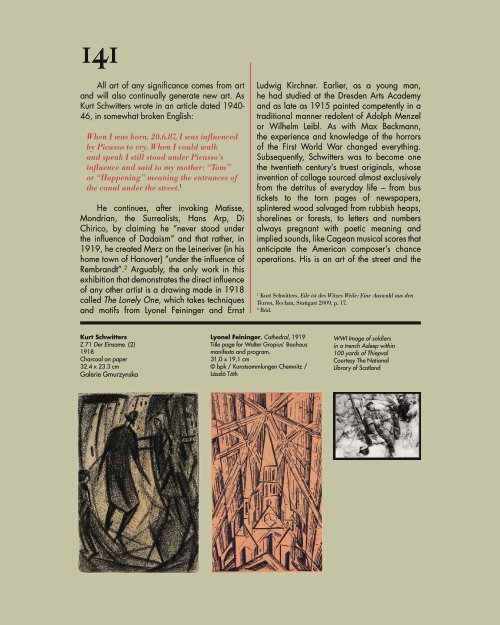Kurt Schwitters: Merz (2016) – Norman Rosenthal interviews Damien Hirst
Fully illustrated catalog published by Galerie Gmurzynska in collaboration with Cabaret Voltaire Zurich on the occasion of Kurt Schwitters: MERZ, a major retrospective exhibition celebrating 100 years of Dada. The exhibition builds and expands on the gallery’s five decade long exhibition history with the artist, featuring exhibition architecture by Zaha Hadid. Edited by Krystyna Gmurzynska and Mathias Rastorfer. First of three planned volumes containing original writings by Kurt Schwitters, historical essays by Ernst Schwitters, Ad Reinhardt and Werner Schmalenbach as well as text contributions by Siegfried Gohr, Adrian Notz, Jonathan Fineberg, Karin Orchard, and Flavin Judd. Foreword by Krystyna Gmurzynska and Mathias Rastorfer. Interview with Damien Hirst conducted by Norman Rosenthal. Includes full color plates and archival photographs. 174 pages, color and b/w illustrations. English. ISBN: 978-3-905792-33-1 The publication includes an Interview with Damien Hirst by Sir Norman Rosenthal about the importance of Kurt Schwitters's practice for Hirst's work.
Fully illustrated catalog published by Galerie Gmurzynska in collaboration with Cabaret Voltaire Zurich on the occasion of Kurt Schwitters: MERZ, a major retrospective exhibition celebrating 100 years of Dada. The exhibition builds and expands on the gallery’s five decade long exhibition history with the artist, featuring exhibition architecture by Zaha Hadid.
Edited by Krystyna Gmurzynska and Mathias Rastorfer.
First of three planned volumes containing original writings by Kurt Schwitters, historical essays by Ernst Schwitters, Ad Reinhardt and Werner Schmalenbach as well as text contributions by Siegfried Gohr, Adrian Notz, Jonathan Fineberg, Karin Orchard, and Flavin Judd.
Foreword by Krystyna Gmurzynska and Mathias Rastorfer.
Interview with Damien Hirst conducted by Norman Rosenthal.
Includes full color plates and archival photographs.
174 pages, color and b/w illustrations.
English.
ISBN:
978-3-905792-33-1
The publication includes an Interview with Damien Hirst by Sir Norman Rosenthal about the importance of Kurt Schwitters's practice for Hirst's work.
Create successful ePaper yourself
Turn your PDF publications into a flip-book with our unique Google optimized e-Paper software.
141<br />
All art of any significance comes from art<br />
and will also continually generate new art. As<br />
<strong>Kurt</strong> <strong>Schwitters</strong> wrote in an article dated 1940-<br />
46, in somewhat broken English:<br />
When I was born. 20.6.87, I was influenced<br />
by Picasso to cry. When I could walk<br />
and speak I still stood under Picasso’s<br />
influence and said to my mother: “Tom”<br />
or “Happening” meaning the entrances of<br />
the canal under the street. 1<br />
He continues, after invoking Matisse,<br />
Mondrian, the Surrealists, Hans Arp, Di<br />
Chirico, by claiming he “never stood under<br />
the influence of Dadaism” and that rather, in<br />
1919, he created <strong>Merz</strong> on the Leineriver (in his<br />
home town of Hanover) ”under the influence of<br />
Rembrandt”. 2 Arguably, the only work in this<br />
exhibition that demonstrates the direct influence<br />
of any other artist is a drawing made in 1918<br />
called The Lonely One, which takes techniques<br />
and motifs from Lyonel Feininger and Ernst<br />
Ludwig Kirchner. Earlier, as a young man,<br />
he had studied at the Dresden Arts Academy<br />
and as late as 1915 painted competently in a<br />
traditional manner redolent of Adolph Menzel<br />
or Wilhelm Leibl. As with Max Beckmann,<br />
the experience and knowledge of the horrors<br />
of the First World War changed everything.<br />
Subsequently, <strong>Schwitters</strong> was to become one<br />
the twentieth century’s truest originals, whose<br />
invention of collage sourced almost exclusively<br />
from the detritus of everyday life – from bus<br />
tickets to the torn pages of newspapers,<br />
splintered wood salvaged from rubbish heaps,<br />
shorelines or forests, to letters and numbers<br />
always pregnant with poetic meaning and<br />
implied sounds, like Cagean musical scores that<br />
anticipate the American composer’s chance<br />
operations. His is an art of the street and the<br />
1<br />
<strong>Kurt</strong> <strong>Schwitters</strong>, Eile ist des Witzes Weile: Eine Auswahl aus den<br />
Texten, Reclam, Stuttgart 2009, p. 17.<br />
2<br />
Ibid.<br />
<strong>Kurt</strong> <strong>Schwitters</strong><br />
Z 71 Der Einsame. (2)<br />
1918<br />
Charcoal on paper<br />
32.4 x 23.3 cm<br />
Galerie Gmurzynska<br />
Lyonel Feininger, Cathedral, 1919<br />
Title page for Walter Gropius’ Bauhaus<br />
manifesto and program.<br />
31,0 x 19,1 cm<br />
© bpk / Kunstsammlungen Chemnitz /<br />
László Tóth<br />
WWI Image of soldiers<br />
in a trench Asleep within<br />
100 yards of Thiepval<br />
Courtesy The National<br />
Library of Scotland

















